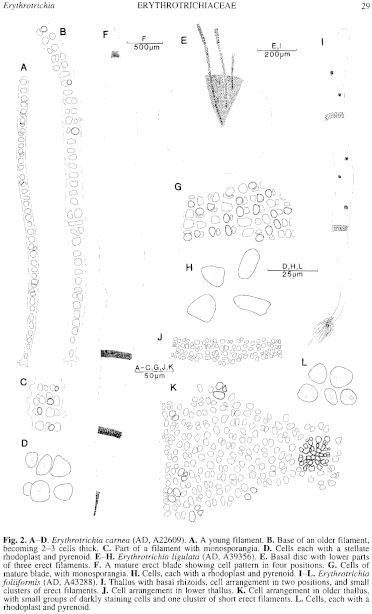|
|
|
|
|
|||||||||||
|
Electronic Flora of South Australia Species Fact Sheet
Phylum Rhodophyta – Class Bangiophyceae – Order Compsopogonales – Family Erythrotrichiaceae
Selected citations: Chapman 1969: 11, fig. 4. Cribb 1983: 10, pl. 1 figs 4–6. Garbary et al. 1980b: 156, fig. 4i, m-p. Heerebout 1968: 151, figs 5–11, 14–18. Kornmann & Sahling 1977: 258, fig. 148A–C; 1985, figs 2–4. Levring 1953: 462. Magne 1990: 157, figs 1–8. Rosenvinge 1909: 67, fig. 8. Tanaka 1952: 14, fig. 7.
Synonyms
E. australis Levring 1953: 462, fig. 1.
Bangia pulchella Harvey 1859b: 342, pl. 195C. J. Agardh 1883: 38.
B. ciliaris subsp. pulchella (Harvey) De Toni 1897: 7.
Thallus (Fig. 2A, B) rose-red, of simple, erect, axes, 1–8 mm high, arising from single, lobed, basal cells or a lax multicellular disc; usually epiphytic. Erect filaments at first uniseriate (Fig. 2A) , often becoming 2–4 cells thick (Fig. 2B), cylindrical, cell divisions diffuse, 6–8 µm in diameter with cells L/B 2–4 near the base, 10–16 (–20) µm in diameter above with cells L/B (0.5–) 1–1.5 (–2), and where 2–4 cells thick then 20–35 µm in diameter with cells isodiametric and 8–12 µm across. Cells (Fig. 2D) with thick gelatinous walls and a single stellate rhodoplast with a central pyrenoid.
Reproduction: Reproduction by monosporangia (Fig. 2B, C) cut off from vegetative cells by a curved wall. Sexual reproduction by 3-celled monoecious gametophytes, with the apical cell producing first a spermatium, then becoming a carpogonium, the zygote then developing a diploid filament surmounting the gametophyte (Magne 1990).
Type from Wales; lost (see Dawson 1953, p. 10).
Selected specimens: Coffin Bay, S. Aust., upper sublittoral on Ceramium (Womersley, 10.i.1951; AD, A13909). Port Stanvac, S. Aust., 3–12 m deep on Polysiphonia on jetty pylon (Clarke & Engler, 14.iv.1979; AD, A50350). Robe, S. Aust., upper sublittoral on Cladosiphon vermicularis on slipway reef (Bailey, 19.xi.1967; AD, A32060). Swan I., Port Phillip, Vic., 0–0.5 m deep on Polysiphonia decipiens on barge (Womersley, 8.iv.1959; AD, A22609). Three Hummocks I., Tas., on Splachnidium (Wollaston & Mitchell, 21.ii.1964; AD, A27637). Bombay Rocks, Low Head, Tas., on Heterozostera (Cribb, 15.ix.1950; AD, A16326). Bicheno, Tas., mid eulittoral on Splachnidium (Gordon, 16.i.1966; AD, A30035).
Distribution: Cosmopolitan as an epiphyte on larger algae.
In southern Australia, widespread but rarely recorded. Levring (1953, p. 462) gave records from Safety Bay, W. Aust., around southern Australia to Heron I., Qld.
Taxonomic notes: Heerebout (1968, p. 151) included E. australis Levring (from Burraneer, N.S.W.) as a synonym of E. carnea, presumably on the basis that his cultures included forms becoming several cells thick (as in E. australis). Most authors consider that E. carnea can become a few cells thick in older parts.
The type of Bangia pulchella Harvey, from Georgetown, Tas. (in TCD), on Heterozostera, has mostly uniseriate filaments, occasionally two cells thick, and is within the range of E. carnea. Harvey's (1859b) Fig. 195C is misleading since the specimen shows only longitudinal "creases" in the cell wall, not a polysiphonous structure.
References:
AGARDH, J.G. (1883). Till algemes systematik. VI. Ulvaceae. Acta Univ. lund. 19(2), 1–182, Plates 1–4.
CHAPMAN, V.J. (1969). The marine algae of New Zealand. Part III: Rhodophyceae. Issue 1: Bangiophycidae and Florideophycidae (Némalionales, Bonnemaisoniales, Gélidiales). (Cramer: Germany.)
CRIBB, A.B. (1983). Marine algae of the southern Great Barrier Reef. Part I. Rhodophyta. (Aust. Coral Reef Soc., Handbook 2: Brisbane.)
DAWSON, E.Y. (1953). Marine red algae of Pacific Mexico. Part I. Bangiales to Corallinaceae subf. Corallinoideae. Allan Hancock Pacif. Exped. 17, 1–239.
DE TONI, G.B. (1897). Sylloge Algarum omnium hucusque Cognitarum. Vol. 4. Florideae. Sect. 1, pp. 1–388. (Padua.)
GARBARY, D.J., HANSEN, G.I. & SCAGEL, R.F. (1980b). The marine algae of British Columbia and northern Washington: Division Rhodophyta (red algae), Class Bangiophyceae. Syesis 13, 137–195.
HARVEY, W.H. (1859b). Algae. In Hooker, J.D., The Botany of the Antarctic Voyage. Flora Tasmaniae. Vol. II, pp. 282–320.
HEEREBOUT, G.R. (1968). Studies on the Erythropeltidaceae (Rhodophyceae - Bangiophycidae). Blumea 16, 139–157.
KORNMANN, P. & SAHLING, P.-H. (1977). Meeresalgen von Helgoland. Benthische Griin-, Braun- and Rotalgen. Helgol. wiss. Meeresunters. 29, 1–292.
KORNMANN, P. & SAHLING, P.-H. (1985). Erythropeltidaceen (Bangiophyceae, Rhodophyta) von Helgoland. Helgoländer Meeresunters. 39, 213–236.
LEVRING, T. (1953). The marine algae of Australia. I. Rhodophyta: Goniotrichales, Bangiales and Némalionales. Arkiv för Bot. Ser. 2, 2, 457–530.
MAGNE, F. (1990). Reproduction sexuée chez Erythrotrichia carnea (Rhodophyceae, Erythropeltidales). Cryptogamie, Algol. 11, 157–170.
ROSENVINGE, L.K. (1909). The marine algae of Denmark. Part 1. Introduction. Rhodophyceae. 1. (Bangiales and Némalionales). K. danske Vidensk. Selsk. Biol. Skr., 7 Raekke, Afd. 7, 1–151, Plates 1, 2,2 maps.
TANAKA, T. (1952). The systematic study of the Japanese Protoflorideae. Mem. Fac. Fish. Kagoshima Univ. 2, 1–92, Plates 1–23.
The Marine Benthic Flora of Southern Australia Part IIIA complete list of references.
Publication:
Womersley, H.B.S. (14 January, 1994)
The Marine Benthic Flora of Southern Australia
Rhodophyta. Part IIIA, Bangiophyceae and Florideophyceae (to Gigartinales)
Reproduced with permission from The Marine Benthic Flora of Southern Australia Part IIIA 1994, by H.B.S. Womersley. Australian Biological Resources Study, Canberra. Copyright Commonwealth of Australia.
Illustration in Womersley Part IIIA, 1994: FIG. 2 A–D.

Figure 2 enlarge
Fig. 2. A–D. Erythrotrichia carnea (AD, A22609). A. A young filament. B. Base of an older filament, becoming 2-3 cells thick. C. Part of a filament with monosporangia. D. Cells each with a stellate rhodoplast and pyrenoid. E–H. Erythrotrichia ligulata (AD, A39356). E. Basal disc with lower parts of three erect filaments. F. A mature erect blade showing cell pattern in four positions. G. Cells of mature blade, with monosporangia. H. Cells, each with a rhodoplast and pyrenoid. I–L. Erythrotrichia foliiformis (AD, A43288). I. Thallus with basal rhizoids, cell arrangement in two positions, and small clusters of erect filaments. J. Cell arrangement in lower thallus. K. Cell arrangement in older thallus, with small groups of darkly staining cells and one cluster of short erect filaments. L. Cells, each with a rhodoplast and pyrenoid.

|
Email Contact: State Herbarium of South Australia |

|